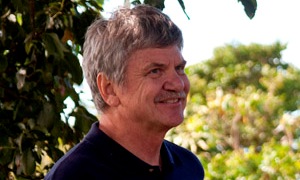Chris Wille, Chief of the Sustainable Agriculture Program at the Rainforest Alliance, talks about the Nespresso AAA Sustainable Quality™ Program and the benefits it brings by improving sustainable livelihoods, conserving biodiversity and protecting the supply of highest quality coffee

The Nespresso AAA Sustainable Quality™ Program has been created in collaboration with the Rainforest Alliance. What expertise has Rainforest Alliance brought to Nespresso for the AAA Program?
In the early 1990s, the Rainforest Alliance and other NGOs in the Sustainable Agriculture Network (SAN) developed the first guidelines for coffee farming defined as socially responsible, environmentally friendly and economically viable. We called this “sustainable agriculture,” and the concept we developed has not only been successful in coffee but has caught on with many different kinds of farming around the world. The conservation and rural development groups who are members of the SAN recognized that if, coffee farmers combined traditional knowledge with modern science, their farms could thrive while at the same time help society meet broader conservation goals and bring wider social and economic benefits.
The Rainforest Alliance and SAN worked with thousands of farmers, agronomists and scientists over several years to combine the best known farming practices into “standards” so that progress toward sustainability could be measured and verified. Experts evaluate farms in the program once a year to see if they are protecting wildlife, conserving forests and other ecosystems, planting trees, safeguarding rivers and streams, providing both temporary and permanent workers with all the proper rights and benefits, controlling pesticides and pollution, and being good neighbors to the local communities.
Nespresso was always interested in sustainability. Its AAA Sustainable Quality™ Program was originally named for the famously high-quality Kenyan AA coffees, with the third “A” denoting sustainability. Nespresso had ample expertise in selecting the highest quality coffee beans. When the company began looking for independent expertise in sustainability, it came naturally to the Rainforest Alliance and SAN. Together, we developed a program called Nespresso AAA Sustainable Quality™, blending our expertise in sustainability and best farming practices with Nespresso’s desire for the highest quality coffee beans.
By working together we were able to answer a simple, but often asked, question: could a farm be socially and environmentally responsible and also produce bulging baskets of gourmet quality beans? We, in the Rainforest Alliance, are excited about demonstrating that doing all the right things for farm workers and the environment could actually improve coffee quality and increase productivity.
How do sustainability standards fit in the Nespresso AAA Program?
The AAA Program, like the SAN standard, was developed in coffee-producing countries with the full support and involvement of farmers. The SAN standard integrates the three spheres of sustainability: economic viability, environmental conservation and social justice. The AAA Program integrates these three sustainability spheres and adds crop quality.
During years of fieldwork in coffee-growing areas, experts in sustainable farm management from the Rainforest Alliance and SAN aided by the coffee quality knowledge of Nespresso and exporting companies explored every detail of farm and mill management. It allowed them to identify social and environmental ameliorations necessary to improve the farms for people and wildlife and also improve the quality of the beans grown.
How is the Nespresso AAA Program concretely applied on farms?
Most of the 45’000 farms in the AAA Program are small, fewer than five hectares. So we help them organize into cohesive clusters. Getting hundreds of fiercely independent smallholders to work together toward common objectives is one of the most challenging parts of the program. But once growers see the benefits of sharing knowledge and resources, they are often enthusiast.
The AAA Program agronomists train farmer leaders, who train others in the techniques that will improve the sustainability of their farms and the quality of their coffee. It’s a cascade of training so every farmer, no matter how remote, gets the information. Farmers already know how to grow coffee, of course. So we provide them with tools and techniques to help them farm smarter, more efficiently, and to make nature an ally.
All farmers welcome advice and new information on the basics of soil and water management, on low-cost, eco-friendly ways to deal with pests and diseases and on how to best prune coffee bushes. The Rainforest Alliance training offered through the AAA Program helps farmers in one country learn from their peers in other countries. The Nespresso experts in quality help explain how small changes in the way that the coffee “cherries” are picked, transported, washed or fermented can affect the quality for better or worse.
How is farmers’ progress within the AAA Program measured?
Trained auditors from the Rainforest Alliance certification program visit the farms and evaluate them according to a special AAA Program scoring tool. It’s not possible to assess every farm in a cluster (some groups have hundreds of small farms), so the auditors select a representative sample. The scores are shared with the farmers and the cluster managers. Trends, challenges and exceptional results are all analysed, and the training is adjusted to ensure continuous improvement.
An increasing number of farms also go through the formal audit process. Those that demonstrate full compliance with the SAN standards earn Rainforest Alliance certification.
So do coffee quality and sustainability form a happy marriage?
There are many beneficial synergies. The forest canopy over coffee bushes provide habitats for countless wildlife species such as birds, mammals, insects and amphibians; and beans that grow in the natural shade are better quality. This is exciting, as everyone wins; the farmers, wildlife and Nespresso club members all benefit.
Protecting streams and the forest ensures that mills have clean water to process the beans and that communities downstream have safe drinking water. Healthy soils, naturally enriched by organic matter, grow better quality coffee. Workers that are well-paid and well-trained are motivated to take care of the coffee from the time the flowers appear to the dried bean at the end of the milling process; guarding the quality every step of the way.
The AAA Program proves that the quality of life for farmers and rural communities, environmental quality and quality in the cup are equally interlinked.
How is the Nespresso AAA Program different from the other programs conceived to help farmers?
There are several standards and certification programs for coffee farming. Some concentrate on eliminating pesticides. Another aims at guaranteeing that producers earn a minimum price. Rainforest Alliance Certified combines the three Es of sustainability: ethics, environment and economy. All these schemes have value and an important role.
Nespresso wanted a program that put quality first without neglecting the sustainability aspects. Together, we developed the AAA Sustainable Quality™ Program on the framework of the SAN sustainability standards and using the proven approach of organizing and training farmers and evaluating their progress through regular, boots-on-the-ground audits.
Nespresso is exceptionally involved with the growers, fielding its own agronomists, providing training, and even funding infrastructure development such as a whole new mill in Colombia.
What is the farmers’ response to the AAA Program? How do they perceive this program?
It’s exciting to see everyone working together with common purpose: environmentalists, agronomists, coffee business people and farmers. I treasure the stories from the field, as when Rainforest Alliance project managers talk about testing new water conservation devices on farms in Colombia or new “climate friendly” farming techniques in Guatemala. And I most enjoy hearing from the farmers themselves, as they show me the improvements they are making.
Many farmers in the AAA Program are bursting with pride and enthusiasm and are eager to talk about their progress. We run from the newly built worker housing to the nursery where baby coffee plants are sprouting to the reforestation area, to the compost pile and up the hill to where a water spring has been properly protected with rings of freshly planted bushes.
I take my cues from the farmers. If they are happy, I’m thrilled.
What would you consider the most meaningful illustration of the AAA Program?
The Rainforest Alliance and Nespresso share a long-term vision. We agree, for example, on what a perfect farm would look like in ten or fifty years, as a changing climate and many other challenges make farming more precarious. Fortunately, some ideal, model farms already exist. For example, Edgar Fernandez and his family manage a wonderful little farm on the slopes of a slumbering volcano in Costa Rica.
Edgar Fernandez manages a sustainable farm in Costa Rica.
The Fernandez family grows bumper crops of fantastic coffee for which Nespresso pays them top prices. They have planted hundreds of native trees in and around the coffee. The wildlife has returned, including one of my favourite birds, the toucan. As a boy, Edgar learned which bird calls signalled that rain is on the way. Now that the birds are back, he is teaching his children to listen to nature.
The farm is almost self-sustaining. They have a garden, fruit trees, herbs for sale at the local market, and pigs. Through a simple fermentation system, the pig manure generates gas for cooking – a home-made biofuel. The family manages the farm together, including picking the ripe red coffee cherries, sometimes trading hand labour with neighboring farms.
For me, the best part is that every member of the family is proud of being a successful coffee farmer. The daughter is going to the university, but she will bring her new business skills back to the farm. That’s sustainability.
